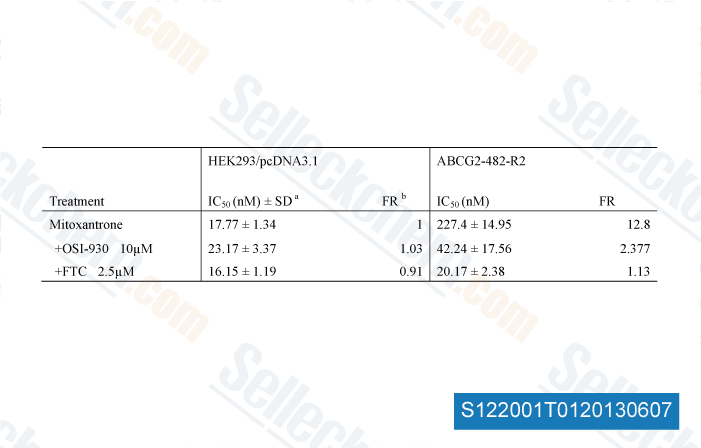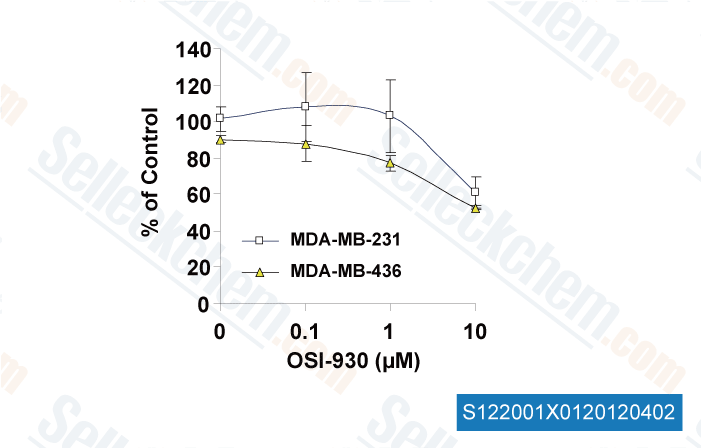|
How to Cite 1. For In-Text Citation (Materials & Methods): 2. For Key Resources Table: |
||
|
Toll Free: (877) 796-6397 -- USA and Canada only -- |
Fax: +1-832-582-8590 Orders: +1-832-582-8158 |
Tech Support: +1-832-582-8158 Ext:3 Please provide your Order Number in the email. We strive to reply to |
Technical Data
| Formula | C22H16F3N3O2S |
||||||||||
| Molecular Weight | 443.44 | CAS No. | 728033-96-3 | ||||||||
| Solubility (25°C)* | In vitro | DMSO | 89 mg/mL (200.7 mM) | ||||||||
| Ethanol | 3 mg/mL (6.76 mM) | ||||||||||
| Water | Insoluble | ||||||||||
| In vivo (Add solvents to the product individually and in order) |
|
||||||||||
|
* <1 mg/ml means slightly soluble or insoluble. * Please note that Selleck tests the solubility of all compounds in-house, and the actual solubility may differ slightly from published values. This is normal and is due to slight batch-to-batch variations. * Room temperature shipping (Stability testing shows this product can be shipped without any cooling measures.) |
|||||||||||
Preparing Stock Solutions
Biological Activity
| Description | OSI-930 is a potent inhibitor of Kit (c-Kit), KDR and CSF-1R with IC50 of 80 nM, 9 nM and 15 nM, respectively; this compound is also potent to Flt-1, c-Raf and Lck and has low activity against PDGFRα/β, Flt-3 and Abl. Phase 1. | |||||||||||
|---|---|---|---|---|---|---|---|---|---|---|---|---|
| Targets |
|
|||||||||||
| In vitro | OSI-930 inhibits the cell proliferation in the HMC-1 cell line with IC50 of 14 nM without significant effect on growth of the COLO-205 cell line that does not express a constitutively active mutant receptor tyrosine kinase. Moreover, this compound also induces apoptosis in HMC-1 cell line with EC50 of 34 nM. [1] A recent study shows that this chemical inactivates purified, recombinant cytochrome P450 (P450) 3A4 with a Ki of 24 μM in a time- and concentration-dependent mode. [2] | |||||||||||
| In vivo | OSI-930, administrated at the maximally efficacious dose of 200 mg/kg by oral gavage, exhibits potent antitumor activity in a broad range of preclinical xenograft models including HMC-1, NCI-SNU-5, COLO-205 and U251 xenograft models. [1] |
Protocol (from reference)
| Kinase Assay:[1] |
|
|---|---|
| Cell Assay:[1] |
|
| Animal Study:[1] |
|
References
|
Customer Product Validation

-
Data from [ BMC Microbiol , 2013 , 13, 249 ]

-
,

-
, , Dr. Yong-Weon Yi from Georgetown University Medical Center
Selleck's OSI-930 Has Been Cited by 8 Publications
| Orthogonal proteogenomic analysis identifies the druggable PA2G4-MYC axis in 3q26 AML [ Nat Commun, 2024, 15(1):4739] | PubMed: 38834613 |
| Small-Molecule and CRISPR Screening Converge to Reveal Receptor Tyrosine Kinase Dependencies in Pediatric Rhabdoid Tumors. [ Cell Rep, 2019, 28(9):2331-2344] | PubMed: 31461650 |
| TLR7/8-agonist-loaded Nanoparticles Promote the Polarization of Tumour-Associated Macrophages to Enhance Cancer Immunotherapy [ Nat Biomed Eng, 2018, 2(8):578-588] | PubMed: 31015631 |
| Targeting a cell state common to triple-negative breast cancers [Muellner MK, et al. Mol Syst Biol, 2015, 11(1):789] | PubMed: 25699542 |
| Dual inhibition of EGFR and MET induces synthetic lethality in triple-negative breast cancer cells through downregulation of ribosomal protein S6 [ Int J Oncol, 2015, 47(1):122-32] | PubMed: 25955731 |
| Dual inhibition of EGFR and MET induces synthetic lethality in triple-negative breast cancer cells through downregulation of ribosomal protein S6. [Yi YW, et al. Int J Oncol, 2015, 47(1):122-32] | PubMed: 25955731 |
| c-KIT signaling is targeted by pathogenic Yersinia to suppress the host immune response. [Micheva-Viteva SN, et al. BMC Microbiol, 2013, 13(1):249] | PubMed: 24206648 |
| OSI-930 analogues as novel reversal agents for ABCG2-mediated multidrug resistance. [Kuang Y, et al. Biochem Pharmacol, 2012, 84(6):766-74] | PubMed: 22750060 |
RETURN POLICY
Selleck Chemical’s Unconditional Return Policy ensures a smooth online shopping experience for our customers. If you are in any way unsatisfied with your purchase, you may return any item(s) within 7 days of receiving it. In the event of product quality issues, either protocol related or product related problems, you may return any item(s) within 365 days from the original purchase date. Please follow the instructions below when returning products.
SHIPPING AND STORAGE
Selleck products are transported at room temperature. If you receive the product at room temperature, please rest assured, the Selleck Quality Inspection Department has conducted experiments to verify that the normal temperature placement of one month will not affect the biological activity of powder products. After collecting, please store the product according to the requirements described in the datasheet. Most Selleck products are stable under the recommended conditions.
NOT FOR HUMAN, VETERINARY DIAGNOSTIC OR THERAPEUTIC USE.
